Shantae: Risky's Revolution - The Last Real Gameboy Advance Game
08/09/25
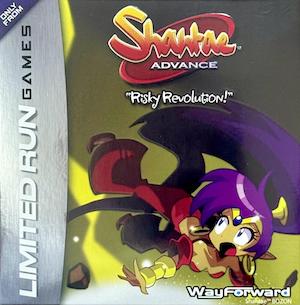
Shantae as a franchise has always been a bit of an enigma to me. Maybe not an enigma, but outside of social media art, I really don’t know what goes on in these parts. Arguably one of the biggest indies of recent decades, Shantae has always had a presence in the background of the gaming space, peddling its very specific style of game and aesthetic to those who adore it. And man, do the fans who adore Shantae, REALLY adore Shantae. After bouncing off previous games, Shantae: Risky’s Revolution is the first Shantae game I’ve really sunk time into. Metroidvanias are my bread and butter; some of them I rank as amongst the best games ever. Where does Shantae lie in that discussion? Well - the Real Last Game Boy Advance title ranks amongst its most charming and its most beautiful - and even with some uninspired dungeon designs and basic, tanky combat, it has enough unique bells and whistles in its core design to pull me through this lovely five-hour adventure.
Back To The Past
Shantae: Risky’s Revolution is fascinating for one particular reason - it’s a genuine, new, major release for the Game Boy Advance. Nearly twenty years after its final release, the GBA lives once more! Of course, it wasn’t as if WayForward just decided to make a GBA game in 2025 - the game was in development for sometime in the early 2000s, following up the original GBC game. However, the game was left without a publisher, and with funds likely drying up, the game was abandoned, and Shantae was on ice for nearly a decade. Until, through the folks at Limited Run Games (damn them), WayForward have been given the chance to finally finish it, giving us what really could be the true Real Last Game Boy Advance game, nearly twenty years after the last game. Though, whilst at its heart Risky’s Revolution is a GBA game, the game actually received a wider release on modern platforms too, with a variety of modes that take advantage of more modern visual design sensibilities - but none of that matters to us, of course! We’re stuck in the Game Boy Abyss, baby!
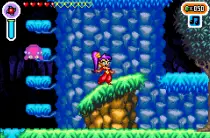
But let’s start there, actually, for once. For a GBA game began in the early 2000s and finished in the mid 2020s, Shantae looks *incredible*. Seriously, it’s one of my favourite looking games on the system, which is almost unfair to everything else because pretty much every trick in the book is available to bring out its best. Character animations, both friendly and unfriendly, are gorgeous and beautifully animated, with a stunning world design that conforms to both the middle-eastern and fantastical aesthetics inherent to Shantae as a whole. And it’s all backed up by a bouncy, upbeat score that feels almost timeless. Particular standouts for the soundtrack at the Boss Battle Theme and the Haunted Grove themes, feeling almost like they’ve jumped out of an old arcade title. But overall, with the advantage of time and a growth of experience, Shantae: Risky’s Revolution is genuinely one of the best looking and best sounding games on the system, and the crown jewel in what’ll probably be the real last ‘big’ GBA release.
A World Dividied
The big elephant in the room regarding my experience with Shanate is based on being just another schmuck stuck on social media; people LOVE how horny Shantae is as a franchise. Pretty much everything I see, both in screenshots and fan art, is just essentially a parade of sexy women - many of them rather giant - ample cleavage, and all manner of other sexualised content. And that’s great! As a known horndog, I’m all for it, but it always left me wondering… what kind of series IS Shantae, actually? Well, at its core, Risky’s Revolution - along with much of Shantae’s greater parent series - is a non-traditional Metroidvania. When one thinks of Metroidvanias, they inevitably think of the gigantic, sprawling, interconnected locales featured in Hollow Knight or Symphony of the Night. But rather than having the world existing as one connected ecosystem, Risky’s Revolution is a stage-based Metroidvania - not in a linear sense, like the pre-SotN Castlevania. Rather, each area is its own (mostly) closed-off zone, with Shantae having an NPC flying her directly to each one. For you Metroid fans, it’s a bit less linear then Metroid Fusion, but a lot more linear then Zero Mission.
I’m not sure if the formula for this game was already baked in twenty years ago, but you follow the same loop of actions to progress through each of the game’s four chapters. Generally, the pace of the game for each is you go to a small-scale town that has been swapped with another, uncover whatever plight their swapped location has encumbered them with, head to a major zone with its own dungeon to unlock and conquer, which upon completing will resolve the aforementioned plight and give you the various McGuffins needed to progress. It’s a fairly repetitive, simplistic loop, but if I were playing this back in the front half of the 2000s, the package this loop exists within feels like it’d be unlike almost anything else you’d see from a non-first party title.
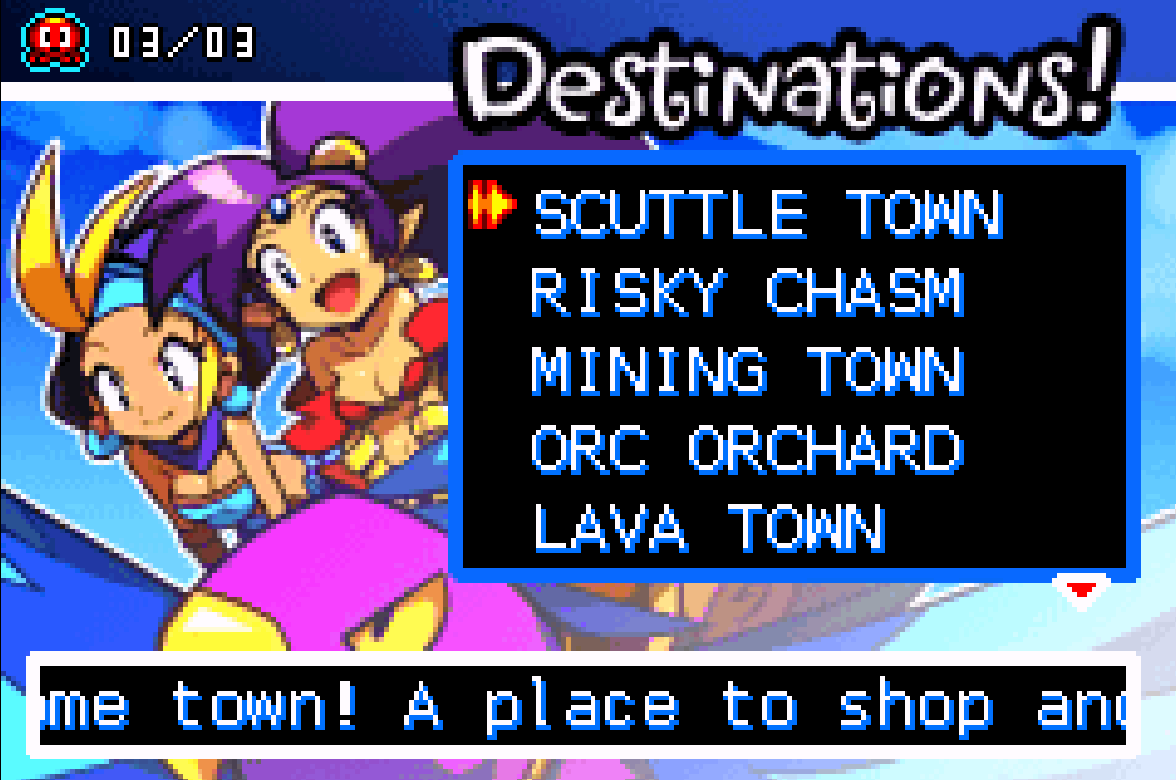
Once you’re in each of these levels, the game begins to feel more like a traditional entry in the subgenre; the slow acquisition of abilities that’ll grow Shantae’s ability to engage with the world around her. Shantae will start with just a basic jump and hair-swipe of an attack, but upon exploring each of the various locales she’s sent to, will uncover new abilities that allow her to access nooks and crannies, not just in the current zone, but in any zones she’s uncovered previously - you just need to actually select that stage, rather than directly making your way too there. I did find a few paths that actually took me from one zone to another, but these felt far and few between and were actually more timewasters than shortcuts.
Sexy, Silly, Sidesplitting
Overall, the game puts a pretty decent focus on its narrative - perennial antagonist Risky Boots, Pirate Queen of Sequin Land, has discovered a way to ‘spin’ parts of the world around, changing the locations of various towns and locales to suit her pirating ways. The bulk of Shantae’s role in stopping Risky Boots is hunting down various Relic Hunters to find a way to resolve and repair the geological happenings before all hell breaks loose.
Really, though, much of the story is just a vehicle for the game to throw out as many amusing one-liners and jokers as possible, and for the most part, this is a very, very funny game. The resolution to the Lava Town subplot, where various, sexy bikini-clad women demand the return of their equally attractive Giant Lady Statue had me giggling more than pretty much anything else I’d seen that week. The moment the shoe dropped, the game danced from titillating to horrific to hilarious in mere moments and I just couldn’t take it. I also found it rather refreshing that, despite so much of the game being caked in the sex appeal of its female cast (and creatures - there’s a lot of horny energy imbued into some of these monster girls), they generally don’t make jokes or generally be creepy about it. It’s very much a ‘yeah, people are hot - move on!’ vibe that I really appreciated.
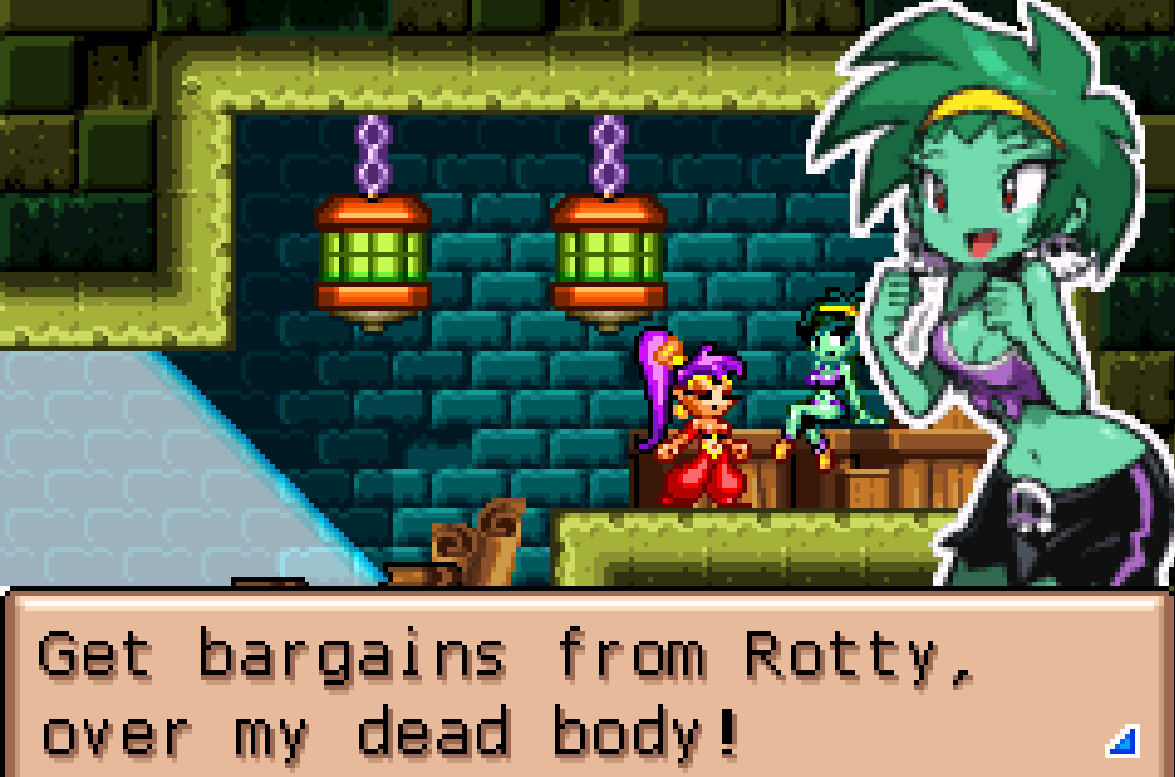
Circular Design
But as I said before, much of the game’s story is based around the fact that Risky Boots has achieved a way to ‘spin’ the world, and this is reflected excellently in the gameplay. When you’re in the game’s major adventuring zones, filled to the brim with enemies and other collectibles, you’ll notice various steel doorframes spread across the world. Interacting them allows you to move into the background of the game, interacting with another plane of enemies, collectibles, puzzles and platforming - sure, it’s simplistic, especially by today’s standards, but having an entire new plane to explore - and deal with enemies who’ll dance between them - is a fairly unique twist (if this came out in 2003).
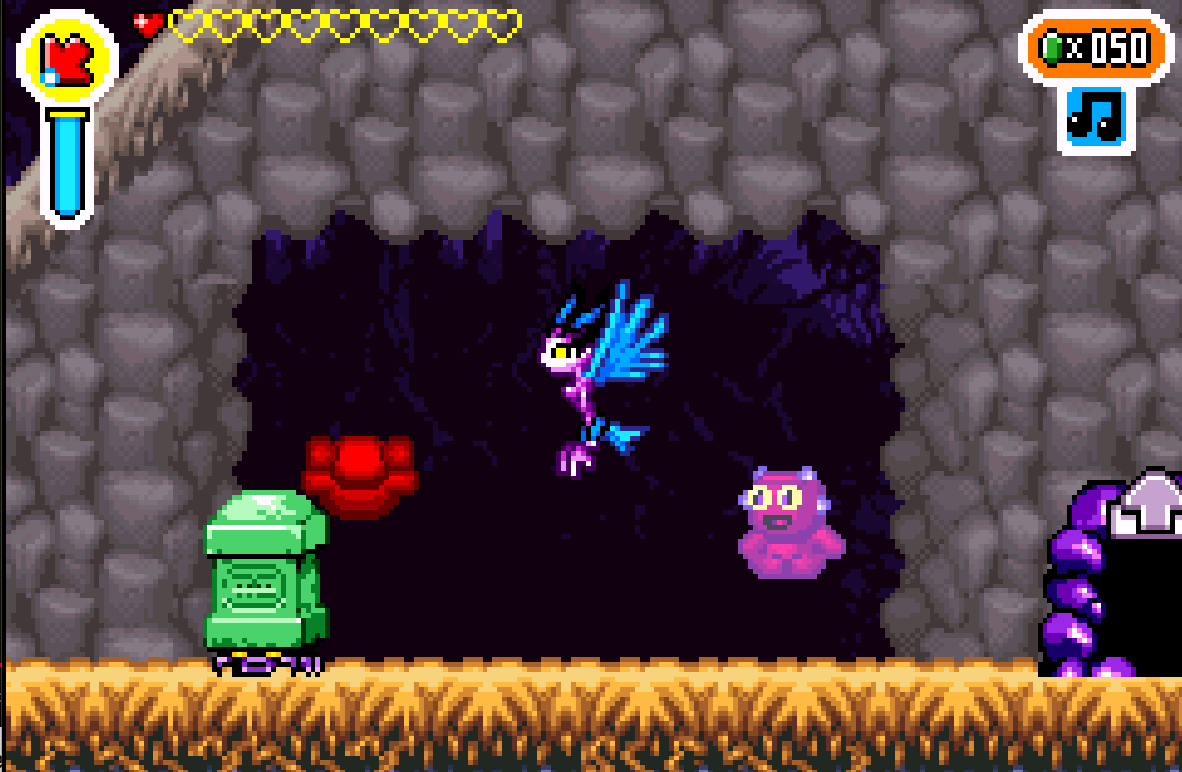
On top of that, keeping in line with Risky’s ability to ‘spin’ the world, each area has a switch that ‘spins’ the background of the world, remixing how the foreground and background ‘lock’ together, unlocking new points of interest, avenues to explore, and free access to various collectibles. Frequently I’d see some cave or collectible sequestered away in the background, with nary a way to get it, but just trying to ‘spin’ the background usually was the ticket to building a pathway. Or if you really want to cheese it, just wait until the end of the game when you gain the ability to fly and literally just soar over anything and everything in your way.
Whilst the core explorative nature of the game is fairly basic, especially for a Metroidvania, the simple dynamic of the background/foreground dynamic adds a *ton* of depth to the game, especially when I found myself hunting the various collectibles and upgrades that are strewn throughout the game. The lack of a map can make keeping track of where everything is in relation to everything else - doubly so when you’re actively twisting the map - but each of these open zones aren’t *too* big, and loop around on themselves, so you literally can just run in one direction until you find whatever you’re looking for. Even beyond just progressing through the game, there’s all manner of little nooks and crannies to unearth. Some of these little nuggets of exploration exist in the open areas, whilst some are in shorter-form dungeons - some of which will give you new abilities not required to progress along the main path, along with the The Traditional random collectible to eke out that ever-alluring 100% completion goal. The act of discovery is at the core of any Metroidvania, and as you amass Shantae’s suite of abilities, it gets more and more fun to engage with that joy within Risky’s Revolution.
Within each of the larger zones is a dungeon Shantae will have to comb through to find her objective, and as opposed to the fun I had exploring the twisting open-zones… these definitely feel like a more rushed element of the game. The actual contents of them are pretty fun - there’s a pretty decent amount of exploration and puzzling action on display here, all fairly varied… but the fact that EVERY dungeon looks exactly the same really bums me out and make them feel a lot longer then they actually are. The game has some fantastic, varied looks to every zone in the game - not only the larger, exploration based ones, but the tiny towns Shantae will visit across her journey. If even a bit of that had been pumped into these stony, dusty tombs, I’d be singing a very different tune. Each dungeon will throw a set of unique puzzles, a bunch of enemy encounter rooms, and culminating in a boss fight with one of Risky Boot’s goons.
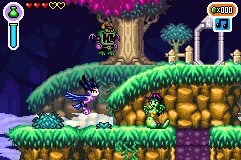
Beyond the dungeons, you’ll also find a number of small caves that usually feature one or two room puzzles, or maybe a miniboss to gatekeep an upgrade. Whilst these also suffered from being samey in look, they didn’t wear out their welcome like the main dungeons, mostly due to their shorter length. But, cave or dungeon, I did like doing them overall, especially as it made me utilize all of Shantae’s talents, but I’d much rather spend my time in the open areas, exploring my heart out. Coupled with a lack of map, not only are they pretty boring to look at, but they’re really easy to get lost in - and you will, as you’ll be charging all over the place hunting for the keys to progress - and more importantly, the transformations that makes Shantae, Shantae.
Shantae’s big gimmick in regards to ability progression is that rather than she, herself, gaining the ability to perform new feats, as a Half-Genie, she learns the ability to shapeshift into various animals and creatures who have the inherent skills to facilitate classic Metroidvania gameplay. You’ll have the Monkey transformation to crawl up walls, the Crab to dive underwater, or the Elephant to smash blockages. Again, it’s fairly simplistic stuff, but I like how it feels a bit more diegetic to Shantae’s character then a lot of other games Metroidvanias - magic transformations *are* her thing, and the way she stumbles on them make sense. It’s not actually an issue, but it’s really funny that all of Samus’s gear keeps just happening to turn up on the planets she’s working on. But back to Shantae; chiefly, I just love how each animal transformation manages to look like their creature they’re emulating, but also keeping Shantae’s identity visible in its design. Monkey, Mermaid, Harpy or Spider, you never feel like a generic creature, but Shantae twisted into another form - she’s universally adorable, and even if some of the abilities are less useful than others, it’s always exciting to see how they look.

Death by a Thousand Hair Swipes
Of course, being an action-based Metroidvania, combat is an important foundation to Risky’s Revolution. Many elements in this game do lay on the more basic side, but it was rarely to the game’s detriment; the combat, on the other hand, does feel genuinely rather middling. I mean, there’s nothing wrong with slapping fools to death with Shantae’s hair, but I never really found combat evolved past that. Sure, a few of Shantae’s transformations can attack, but they’re own combative abilities rarely evolve past a bunch of energy bolts or basic bombs. The suite of abilities Shantae can buy from Rotty’s shop throughout the game also failed to impress me - the damaging abilities, like the Fireball or Storm Cloud never felt overly effective compared to the ‘ol hair swipe, and the more platform-orienting ones I found even less use for - sans one that allowed me to run on thin air that surprisingly let me skip a few platforming challenges here and there.
Thankfully the game does control very well, with very accurate, snappy inputs and overall just a very nice sense of feedback from the more ‘gun-like’ abilities. No matter if it was combat or exploration, anytime I didn’t make a jump or got Shantae’s head clocked by an enemy, typically it was my fault. Also, shout-out to the Spider attack upgrade. Seriously, using Shantae’s Spider-form as a machine gun was probably the best this game got in regards to combat - take that as you will, but it doesn’t help that the combat just isn’t *interesting*.
It’s a shame, but this basic combat depth impacts the boss encounters of the game, an element of any game that I place a LOT of weight on. The game has a smattering of unique, engaging boss encounters , along with a few repeats of mini-boss fights. The repetition of these latter fights didn’t bother me, since they’re fast-paced, engaging affairs where single mistakes can be devastating. But, like other elements, the fights err on the simpler side of mechanics, Also, after the first few fights, the amount of health these fights have seem to balloon to insane numbers - the second phase of the final boss encounter felt like it was a solid five plus minutes of me wailing on it with seemingly no progress, unhelped by the fact that it was one of the least enjoyable encounters in the game. Now, I’m sure there are the crazy people who’ve already skinned this game alive, beating everything without taking damage, but I’m just a schmuck who’s bad at video games - if some of these fights had half their actual health, it’d be a lot more fun.
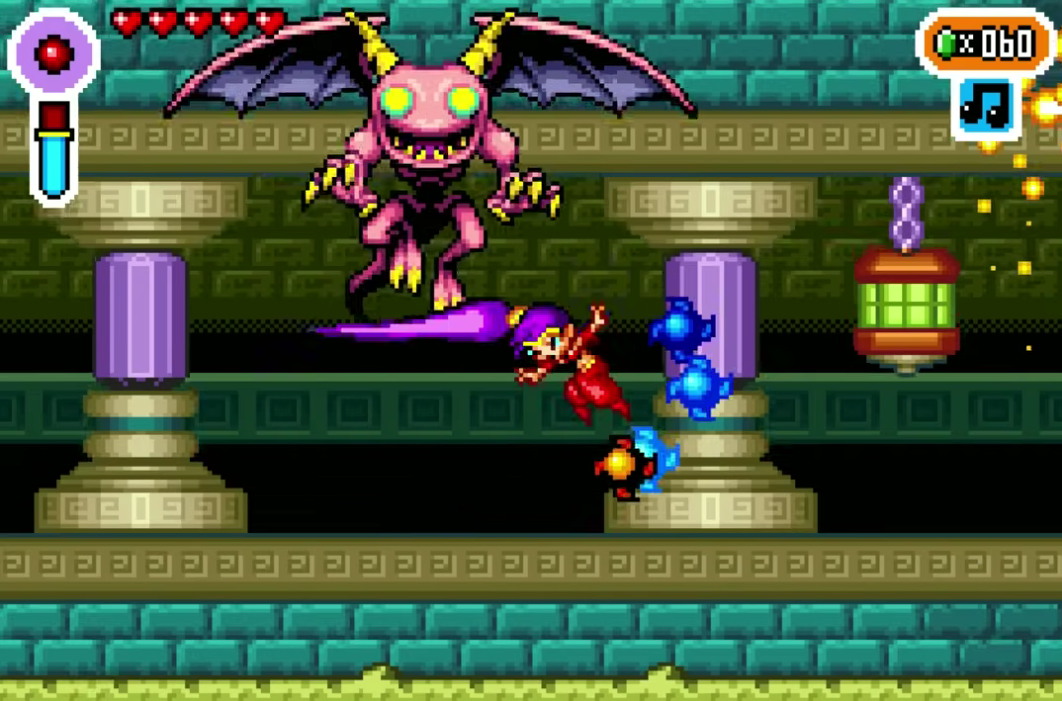
I really don’t mind having to ‘git gud’, but the length of these fights, and the fact the game almost seems to encourage you to buy health refills to survive the onslaughts, just doesn't work for me. Honestly, this element of the boss fights, alongside the more repetitive dungeons and overall repetitive structure of the game (again, the latter of which I really don’t mind) are probably the elements of the game that feel the most like they were cemented in it’s original, early 2000s dev cycle.
I like Shantae: Risky’s Revolution, but I really wanted to LOVE it. What’s good here is very, very good - it’s a great example of a more stringent, linear, yet still Metroidvania format, and it’s very much one of the most beautiful games on the GBA. The joy of discovery is alive and well, but it’s just got some foundational issues to stop it from being an all-timer. With some more unique dungeon environments, a few more interesting combat options, and a bit of a rebalance in the boss department, this could’ve become one of my favourite games on the Game Boy Advance. But, at the end of the day, this is for the die-hards of the Shantae crowd, the people who are always retweeting and discussing and gushing over the possibility of whatever comes next. I’m not a Shantae guy, but I think I’ve learnt enough to say that Shantae fans will be eating REAL good when it comes to Risky’s Revolution.
Thanks for reading my review of Shantae: Risky’s Revolution! Crazy to be reviewing a brand new, ‘big’ Game Boy Advance game in the big 25! Bit of a bigger review this time, but considering it’s both a Metroidvania and a brand new title, so I hope y’all din’t mind that. As always, if you ever have any questions or requests, you can email me at mgeorge7003@hotmail.com or cckaiju@gmail.com. Thanks again, and I’ll see you next time!
